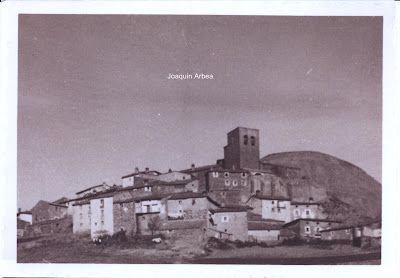
Esco, Aragon, North-West of Spain, in 1950.Picture courtesy of Joaquin Arbea.
Current Status: 3 people.
Altitude: 580 meters.
Distance in miles:
Sos del Rey Catholic: 39 km.
Zaragoza: 159 km.
Madrid: 411 km.
Access: Highway passes of the Pyrenees 400 meters from the village. A short walk of 5 minutes.
District: The Jacetania.
Thanks to Jose Luis Clemente extraordinary, president of the Association for the reconstruction of Esco, for their unconditional cooperation in preparing this article.
Thanks for everything, José Luis.
The third of the villages killed by the construction of the dam of Yesa was the beautiful village of Esco (the other two are Tiermas and Ruesta) was the smallest of the three, but was the only one who has never become completely depopulated. Of a house always comes out the chimney smoke in the cold days of winter, to teach all who pass hurriedly by the road, although Esco has been agonizing for many years, has never come to die, so least in regard to human presence.
We present the people of Esco in a half moon resting on a hill called Calvary. Made up of two districts (Upper and Lower), distributed its 60 houses in three streets (Low, Medium and High).
It had good farmland on the banks of the river Aragon (where now are the waters of the reservoir), devoted to crops were irrigated as beans, potatoes, cabbage, chard, tomatoes, etc.. being the furthest from the river land for dry farming (barley, wheat and oats in particular), while the hills situated above the town were for grazing sheep and to a lesser extent goats.
They were a people who enjoyed self-sufficiency, because of good products that tore the land and the quality of meat they raised, which was missing the swine, rabbits, chickens and pigeons, also was consumed lamb, they sold the people they had sheep and to a lesser extent beef that was more difficult to achieve. There was a house where they sold fish (Pellón house) and another where he was the village shop (home Tiopedro) and you could get a bit of everything in general, even the bread they made this house for sale, when people did not do their own bread in the ovens that were in each house.
From the 50's, cause of good communication bus that was on the road, flocked to Sangüesa fat to make purchases and provided plants for the gardens.
Also it had 2 bars, although in earlier times came to be four.
Counted with electric light in homes before the war, from a small plant that was in Tiermas. In the early 50's there was a flood that was the central front and had to return to the light of the carbides, until about the year 57 was a transformer to bring the light from Jaca.
It was not the case for water. There was a project to bring water to the edge of town, but whatever the people were sentenced was not carried forward. The water was brought in onganetas (wicker baskets), whether in horses or burros. In the houses had earthen jars of 150 l. and was stored there.
As basic services are concerned, there was resident priest in Esco until 1950 and thereafter was to Sigüés which came to officiate at religious services. There was also always master and teacher residing in the village, from the year 63 when they had few school-age children, the school was mixed and there were only teacher.
The postman also resided in the village, like the blacksmith.
The doctor came from Tiermas, just as the veterinarian, in recent years and the first came from Sigüés while the second made him from Salvatierra de Esca.
The festivities were held on the day of St. Michael (September 29), but it was busy time with the cattle were changed from date to the early twentieth century, becoming the 30th of November for San Andres.
Lively parties where the dance was missing was done in a salon of Casa Marcelo, well entertained by musicians from orchestras or by people from other nations, as were the musicians Lumbier.
There was no lack either the rounds, where the young men playing guitar and the mandolin sang jacks at the gates of the home and took viands they offered them (eggs, bacon, sausage, etc.). With working a dinner. The girls were doing chocolate for a snack and they used more revelers gather at dawn, and finish the dance, eat a few crumbs made at the time.
Each September 8, day of the Nativity of the Virgin, it had a habit of making a procession to the hermitage of the Virgen de las Viñas, distant about 800 meters from the village, the procession was repeated last day of the Ascension.
The amusements were those of that time in the little free time he had, the men went to take a sip of wine and play cards in bars, dancing boys and girls organized on Sunday, it resorted to Judas (Matias Figoli) who played the mandolin and violin playing Rebolé, along with some boy who played a little guitar and I had the orchestra. Each waiter brought what I could and it paid the musicians and they made a snack.
Despite the peaceful life of the people, the sword of Damocles hanging over Esco, since from 1930 and the project was underway to make the swamp, they warned residents not to perform home improvements that they are not would pay. Early in the 50's most fertile land expropriated, standing by the river, which the people took their main livelihood. In the law of eminent domain in 1953, included a clause which permitted the expropriation could ask to be expropriated other assets to draw some money to start over somewhere else, since the floodplain were not paid a price gold, which not only ran out of their way of life forever but also not getting enough money to start a new life elsewhere. They were encouraged to ask the city council the expropriation of the people, saying that if anyone wanted to return could do so whenever I wanted, but the reality was different, as you said José Luis Clemente:
'' In 1978 we request the reversal of the house with my grandfather and the resounding answer was NO because they say that the expropriation was voluntary. Later in 1998 I initiated a dispute against CHE and in 2006 the High Court of Justice of Aragon gave me negative response and the advice of counsel not resorted to the Supreme Court (if I had won the lottery, I really would still be litigating).
As always we have indicated the ban on entering the houses and then the frustration of not being able to do anything legal to keep.''
A traumatic decision for pelaos (nickname which was known to the inhabitants of Esco), having to leave behind a lifetime and some roots that would be left buried forever with the progress of the neighbors.
'' I often was telling my father why have not stood up. The answers were clear: In former times, had they would have opposed the Civil Guard sent to evict them, just did as they advised, also instilled in them they had to leave the village to give them a better life for their children, in terms this issue what is sacrificed father for her children? So the vast majority did what they said, acting in good faith, and opted out, people were marching in steps as could be done with other property besides that deceived them by telling them if anyone could return as soon repented wanted, which was not fulfilled.''
In the middle of the 60 had severely depleted the population, but even in 1965 there was a birth in Esco, as was that of Marisa Sanchez Canton House, which was the last born in the village.ecalls those years of uncertainty Jose Luis Clemente:
Also in 1965 there was an anecdote, as was the first car that was in Scotland, a Seat 850 owned by Mario Sanchez and Maria Momo Tiopedro House.
So things, people continued to live in Esco until the early 70's, mostly pelaos marched in Pamplona and Zaragoza, some families to San Sebastian, and some other Barbastro, Reus and Madrid.
Only Felix Guallar and his family chose to stay in town. As had sheep, which was their livelihood would not go, Felix was from Buyero House but left alone in the village chose to move to live in House Guallar, that brought together best. Felix died in 2010 but three of his children (Felix, Baltasar and Evaristo) have continued with cattle and continue to daily human presence on the streets of Esco.
The old neighbors and their descendants in some cases requested the reversal of the houses, which have not been made any case, which together with the rapid deterioration that were taking houses and heritage of the people, made to organize and 1999 created the Association for the reconstruction of Esco, getting rehabilitate the shrine of the Virgen de las Viñas which was in ruins, as well as the cemetery and look after the interests of the people, as it could be a recovery and reconstruction of buildings, as well as rescue and promote the customs and traditions that were in the village.
For all that have created a website with all the town's history, a blog, notebooks of all place names in Esco and published annually by the Herald of Esco (very interesting this publication) which account for all activities of the association, remnants of the town's history and all kinds of news that are related to the people.
The escotanos who have left and their descendants gather each year on May 1, where they celebrate a day of fellowship, make a Mass in the chapel, a picnic and other cultural activities and entertainment, all for you will not miss memory and the roots of Esco.
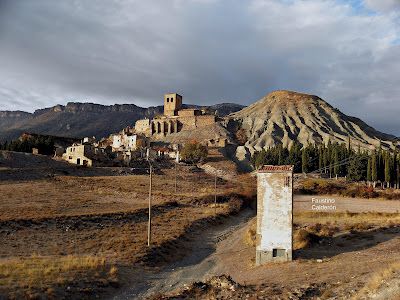
View of Esco from the road.
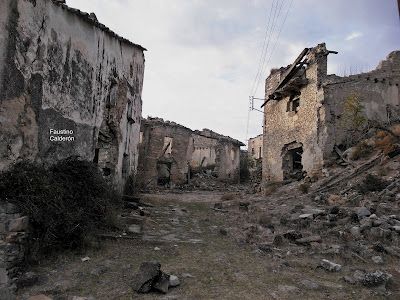
Entrance to Esco. Low Street.

House of Mariano Rita and House of Zamborán.At the end: House of Navarro.
.JPG)
From left to right: House The Teacher; thwy went to Pamplona, before 1960. House Blas of the Lessor;there lived the uncle Blas, who was alone; he died in 1964. House The American man; that was the only one house that had wc.House La Caminera or Aja; they went to Burlada (Navarra) at the begining of 60´.
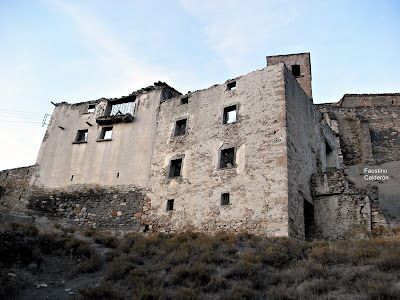
Middle street.House Orosieta; there lived the mother and her three sons; they were the last people who leaved Esco.To the right: House of Tiopedro; he had a shop and also he made bread, once in a week.The owners of this house had the first one car in Esco (a Seat 850).
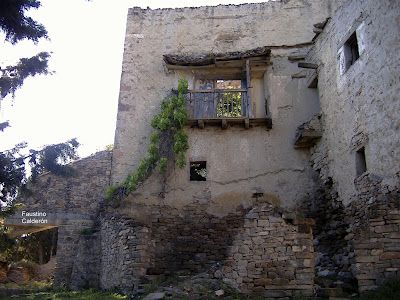
Low Street.House Lobera.In the 40´, this house was brought by the lady Ramona Mayayo and her husband.The last years, this house was habited by the family Orduña.

School of Esco.Down were the boys and up the girls.In the 60´, as there were only twelve students, the school became mixed.
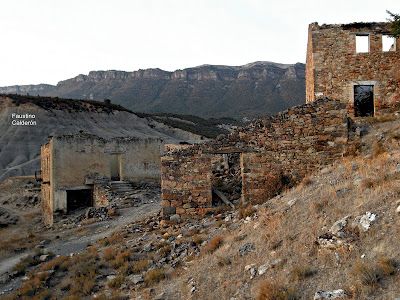
Low Street.House Lerrero, to the left; blacksmith house, in the middle; and the school to the right.
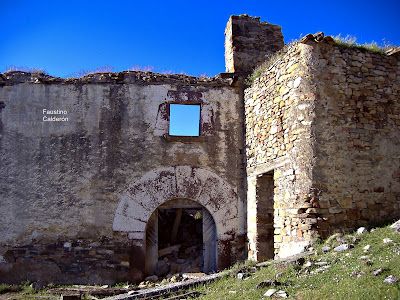
Middle Street.House Momó.It was a very big house.In it lived two brothers and one sister (Leopoldo, Alejandro and Rufina Odériz).On the arch of the main door, you can see a rosebush, in the Coat of arms.Moreover, there was another rosebush close the door.Then, when boys of the village went out as a round, they stopped outside the door and they sang one jot: "In the door of Momó, there is a rosera (it is a word similar than rosebush) very fine, you can not take the rose, without permission of Rufina".
.JPG)
Back of House Laguau.Here, there was a dance hall and a cinema.In the 60´, a man from Salvatierra de Esca projected a movie in the livingroom of this house; it was a great new in Esco.
.JPG)
Parish Church of San Miguel.
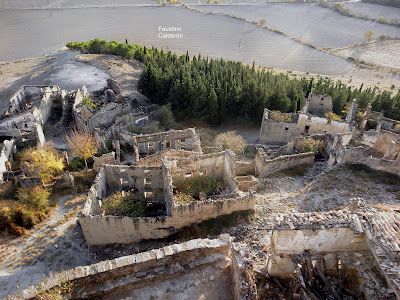
View of the slum, from the steeple of the church.
.JPG)
Slum.In the first term: House Torrea; they went to Pamplona.At the end: House Ventura.
.JPG)
Uptown.To the left: House Buyero; to the right: House the Teacher.
.jpg)
Family of House Buyero in 1956.
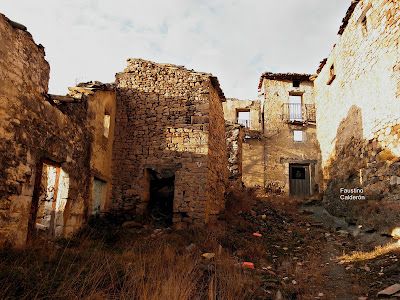
House Buyero, 56 years later.This is the same picture that the previous one.

High Street.House of the shearer.This man had two daughters and two sons: Aurelia, Santos, Agustina and Cecilio.Santos was the last Mayor in Esco.
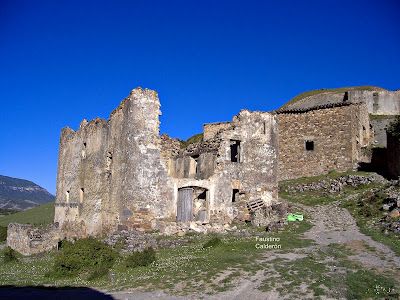
House Cantón.It was one of the last houses built, in Esco.
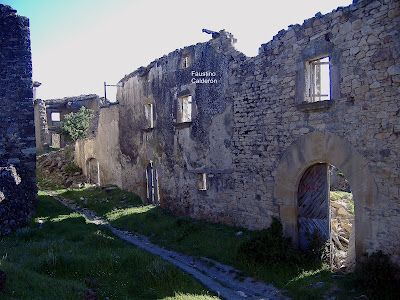
High Street.
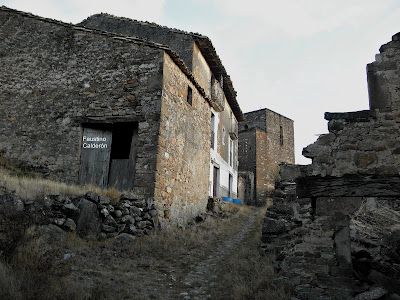
High Street.House Guallar.In the middle: the only one house that is habited.
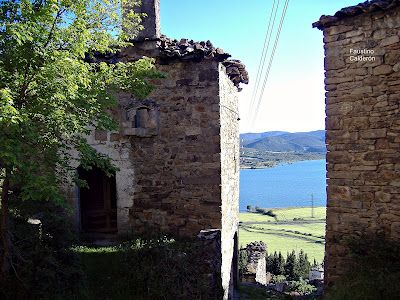
House the School.At the end: the swamp of Yesa.
I hope that you liked this report.
Kind regards,
Luis.
Sponsored by Costaluz Lawyers
(Click down here):
.jpg)